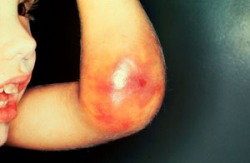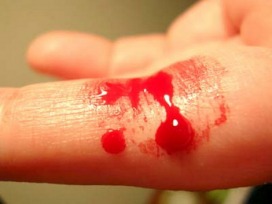Symptoms
The most obvious signs for hemophilia are excessive bleeding and easy bruising.
Excessive bleeding
The severity of the bleeding depends on the type of hemophilia. Children with moderate hemophilia may not show symptoms until a surgery, dental procedure or an accident. However adult males with severe hemophilia may bleed profusely after circumcision. Bleeding could also be either internal, or external.
Internal bleeding
Some signs of internal bleeding include blood in the urine and blood in the stool. Bleeding in the joints is another big problem people with hemophilia have. The bleeding causes no obvious pain at first but soon becomes swollen, warm to touch, and painful to bend. The swelling steadly increases until the movement of the joint is temporarily lost. The pain can become quite severe.
Bleeding in an elbow joint

Bleeding in the brain is a very serious symptom people with hemophilia have to worry about. It is also very easy for a person with hemophilia to come across a complication such as this. A simple bump to the head or a more serious injury can easily cause this to happen. Some symptoms of bleeding in the brain are long lasting headaches, soreness/stiffness in the neck, double vision, and having trouble walking and/or coordinating body movement.
Testing and Diagnosing
Testing
To begin testing for hemophilia doctors will often take a detailed history of your own and family medical reports, to find clues on your condition. Next would be blood tests, these will tell how long it takes for your blood to clot, whether or not your blood has low levels of any of the cloting factors or if a factor just isn't present at all. The test results will show if you have hemophilia, what type and how severe the disorder is. The bleeding problems for both hemophilia A and B are the same, you can only tell by special blood tests. It is important to know which type you have because the treatments are differant.

